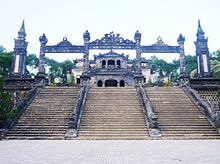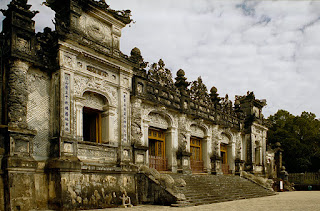สุสานจักรพรรดิ์ไคดิงห์ เมืองเหว้ จังหวัดเถื่อเทียน สาธารณรัฐสังคมนิยมเวียดนาม.
Khai Dinh Tomb, Hue, Vietnam.
Photo Gallery. Asian Historical Architecture.
ขอบคุณ ข้อมูลและภาพ จาก http://www.orientalarchitecture.com/sid/669/vietnam/hue/khai-dinh-tomb
Khai Dinh Tomb (built 1920-31)
This is the final resting place of Khai Dinh, Emperor of Vietnam from 1916-1925. The tomb represents a fusion of traditional Vietnamese style and modern influence. Begun in 1920 and completed in 1931, the tomb is almost entirely made of concrete and includes many European architectural details, likely inspired by the Emperor's visit to France in 1922 where he viewed the Marseilles Colonial Exhibition.
Khai Dinh was an extremely unpopular ruler during his lifetime, mostly due to his close collaboration with the French. To finance the tomb, he requested permission of the French advisors to raise taxes on the peasantry, which they allowed. Although he died prematurely at age 40 of tuberculosis, his son and successor, Bao Dai, completed the tomb several years later. Bao Dai would prove to be the final ruler of the Nguyen dynasty and lived until 1997. Thus, the tomb of Khai Dinh became the last grand imperial tomb in Vietnam.
Plan view
Image adapted from signpost located on site.Location
The approximate location of the site is 16.398926' N, 107.590263' E (WGS 84 map datum).
01.Khai Dinh Tomb, Hue, Vietnam. Photo Gallery. Asian Historical Architecture.
สุสานจักรพรรดิ์ไคดิงห์ เมืองเหว้ จังหวัดเถื่อเทียน สาธารณรัฐสังคมนิยมเวียดนาม.
02.Khai Dinh Tomb, Hue, Vietnam. Photo Gallery. Asian Historical Architecture.
สุสานจักรพรรดิ์ไคดิงห์ เมืองเหว้ จังหวัดเถื่อเทียน สาธารณรัฐสังคมนิยมเวียดนาม.
03.Khai Dinh Tomb, Hue, Vietnam. Photo Gallery. Asian Historical Architecture.
สุสานจักรพรรดิ์ไคดิงห์ เมืองเหว้ จังหวัดเถื่อเทียน สาธารณรัฐสังคมนิยมเวียดนาม.
04.Khai Dinh Tomb, Hue, Vietnam. Photo Gallery. Asian Historical Architecture.
สุสานจักรพรรดิ์ไคดิงห์ เมืองเหว้ จังหวัดเถื่อเทียน สาธารณรัฐสังคมนิยมเวียดนาม.
05.Khai Dinh Tomb, Hue, Vietnam. Photo Gallery. Asian Historical Architecture.
สุสานจักรพรรดิ์ไคดิงห์ เมืองเหว้ จังหวัดเถื่อเทียน สาธารณรัฐสังคมนิยมเวียดนาม.
06.Khai Dinh Tomb, Hue, Vietnam. Photo Gallery. Asian Historical Architecture.
สุสานจักรพรรดิ์ไคดิงห์ เมืองเหว้ จังหวัดเถื่อเทียน สาธารณรัฐสังคมนิยมเวียดนาม.
07.Khai Dinh Tomb, Hue, Vietnam. Photo Gallery. Asian Historical Architecture.
สุสานจักรพรรดิ์ไคดิงห์ เมืองเหว้ จังหวัดเถื่อเทียน สาธารณรัฐสังคมนิยมเวียดนาม.
08.Khai Dinh Tomb, Hue, Vietnam. Photo Gallery. Asian Historical Architecture.
สุสานจักรพรรดิ์ไคดิงห์ เมืองเหว้ จังหวัดเถื่อเทียน สาธารณรัฐสังคมนิยมเวียดนาม.
09.Khai Dinh Tomb, Hue, Vietnam. Photo Gallery. Asian Historical Architecture.
สุสานจักรพรรดิ์ไคดิงห์ เมืองเหว้ จังหวัดเถื่อเทียน สาธารณรัฐสังคมนิยมเวียดนาม.
10.Khai Dinh Tomb, Hue, Vietnam. Photo Gallery. Asian Historical Architecture.
สุสานจักรพรรดิ์ไคดิงห์ เมืองเหว้ จังหวัดเถื่อเทียน สาธารณรัฐสังคมนิยมเวียดนาม.
11.Khai Dinh Tomb, Hue, Vietnam. Photo Gallery. Asian Historical Architecture.
สุสานจักรพรรดิ์ไคดิงห์ เมืองเหว้ จังหวัดเถื่อเทียน สาธารณรัฐสังคมนิยมเวียดนาม.
12.Khai Dinh Tomb, Hue, Vietnam. Photo Gallery. Asian Historical Architecture.
สุสานจักรพรรดิ์ไคดิงห์ เมืองเหว้ จังหวัดเถื่อเทียน สาธารณรัฐสังคมนิยมเวียดนาม.
13.Khai Dinh Tomb, Hue, Vietnam. Photo Gallery. Asian Historical Architecture.
สุสานจักรพรรดิ์ไคดิงห์ เมืองเหว้ จังหวัดเถื่อเทียน สาธารณรัฐสังคมนิยมเวียดนาม.
14.Khai Dinh Tomb, Hue, Vietnam. Photo Gallery. Asian Historical Architecture.
สุสานจักรพรรดิ์ไคดิงห์ เมืองเหว้ จังหวัดเถื่อเทียน สาธารณรัฐสังคมนิยมเวียดนาม.
15.Khai Dinh Tomb, Hue, Vietnam. Photo Gallery. Asian Historical Architecture.
สุสานจักรพรรดิ์ไคดิงห์ เมืองเหว้ จังหวัดเถื่อเทียน สาธารณรัฐสังคมนิยมเวียดนาม.
16.Khai Dinh Tomb, Hue, Vietnam. Photo Gallery. Asian Historical Architecture.
สุสานจักรพรรดิ์ไคดิงห์ เมืองเหว้ จังหวัดเถื่อเทียน สาธารณรัฐสังคมนิยมเวียดนาม.
17.Khai Dinh Tomb, Hue, Vietnam. Photo Gallery. Asian Historical Architecture.
สุสานจักรพรรดิ์ไคดิงห์ เมืองเหว้ จังหวัดเถื่อเทียน สาธารณรัฐสังคมนิยมเวียดนาม.
18.Khai Dinh Tomb, Hue, Vietnam. Photo Gallery. Asian Historical Architecture.
สุสานจักรพรรดิ์ไคดิงห์ เมืองเหว้ จังหวัดเถื่อเทียน สาธารณรัฐสังคมนิยมเวียดนาม.
19.Khai Dinh Tomb, Hue, Vietnam. Photo Gallery. Asian Historical Architecture.
สุสานจักรพรรดิ์ไคดิงห์ เมืองเหว้ จังหวัดเถื่อเทียน สาธารณรัฐสังคมนิยมเวียดนาม.
20.Khai Dinh Tomb, Hue, Vietnam. Photo Gallery. Asian Historical Architecture.
สุสานจักรพรรดิ์ไคดิงห์ เมืองเหว้ จังหวัดเถื่อเทียน สาธารณรัฐสังคมนิยมเวียดนาม.
21.Khai Dinh Tomb, Hue, Vietnam. Photo Gallery. Asian Historical Architecture.
สุสานจักรพรรดิ์ไคดิงห์ เมืองเหว้ จังหวัดเถื่อเทียน สาธารณรัฐสังคมนิยมเวียดนาม.
22.Khai Dinh Tomb, Hue, Vietnam. Photo Gallery. Asian Historical Architecture.
สุสานจักรพรรดิ์ไคดิงห์ เมืองเหว้ จังหวัดเถื่อเทียน สาธารณรัฐสังคมนิยมเวียดนาม.
23.Khai Dinh Tomb, Hue, Vietnam. Photo Gallery. Asian Historical Architecture.
สุสานจักรพรรดิ์ไคดิงห์ เมืองเหว้ จังหวัดเถื่อเทียน สาธารณรัฐสังคมนิยมเวียดนาม.
24.Khai Dinh Tomb, Hue, Vietnam. Photo Gallery. Asian Historical Architecture.
สุสานจักรพรรดิ์ไคดิงห์ เมืองเหว้ จังหวัดเถื่อเทียน สาธารณรัฐสังคมนิยมเวียดนาม.
25.Khai Dinh Tomb, Hue, Vietnam. Photo Gallery. Asian Historical Architecture.
สุสานจักรพรรดิ์ไคดิงห์ เมืองเหว้ จังหวัดเถื่อเทียน สาธารณรัฐสังคมนิยมเวียดนาม.
26.Khai Dinh Tomb, Hue, Vietnam. Photo Gallery. Asian Historical Architecture.
สุสานจักรพรรดิ์ไคดิงห์ เมืองเหว้ จังหวัดเถื่อเทียน สาธารณรัฐสังคมนิยมเวียดนาม.
27.Khai Dinh Tomb, Hue, Vietnam. Photo Gallery. Asian Historical Architecture.
สุสานจักรพรรดิ์ไคดิงห์ เมืองเหว้ จังหวัดเถื่อเทียน สาธารณรัฐสังคมนิยมเวียดนาม.
28.Khai Dinh Tomb, Hue, Vietnam. Photo Gallery. Asian Historical Architecture.
สุสานจักรพรรดิ์ไคดิงห์ เมืองเหว้ จังหวัดเถื่อเทียน สาธารณรัฐสังคมนิยมเวียดนาม.
29.Khai Dinh Tomb, Hue, Vietnam. Photo Gallery. Asian Historical Architecture.
สุสานจักรพรรดิ์ไคดิงห์ เมืองเหว้ จังหวัดเถื่อเทียน สาธารณรัฐสังคมนิยมเวียดนาม.
30.Khai Dinh Tomb, Hue, Vietnam. Photo Gallery. Asian Historical Architecture.
สุสานจักรพรรดิ์ไคดิงห์ เมืองเหว้ จังหวัดเถื่อเทียน สาธารณรัฐสังคมนิยมเวียดนาม.
31.Khai Dinh Tomb, Hue, Vietnam. Photo Gallery. Asian Historical Architecture.
สุสานจักรพรรดิ์ไคดิงห์ เมืองเหว้ จังหวัดเถื่อเทียน สาธารณรัฐสังคมนิยมเวียดนาม.
32.Khai Dinh Tomb, Hue, Vietnam. Photo Gallery. Asian Historical Architecture.
สุสานจักรพรรดิ์ไคดิงห์ เมืองเหว้ จังหวัดเถื่อเทียน สาธารณรัฐสังคมนิยมเวียดนาม.
33.Khai Dinh Tomb, Hue, Vietnam. Photo Gallery. Asian Historical Architecture.
สุสานจักรพรรดิ์ไคดิงห์ เมืองเหว้ จังหวัดเถื่อเทียน สาธารณรัฐสังคมนิยมเวียดนาม.
34.Khai Dinh Tomb, Hue, Vietnam. Photo Gallery. Asian Historical Architecture.
สุสานจักรพรรดิ์ไคดิงห์ เมืองเหว้ จังหวัดเถื่อเทียน สาธารณรัฐสังคมนิยมเวียดนาม.
Photo Gallery. Asian Historical Architecture.
ขอบคุณ ข้อมูลและภาพ จาก http://www.orientalarchitecture.com/sid/669/vietnam/hue/khai-dinh-tomb
-------------------------------------------------------------
ขอบคุณ ข้อมูลและภาพ จาก https://en.wikipedia.org/wiki/Tomb of Khải Định
Tomb of Khải Định
From Wikipedia, the free encyclopedia
| Tomb of Emperor Khải Định | |
|---|---|
 | |
| Basic information | |
| Location | Huế, Vietnam |
| Province | Thừa Thiên, Huế |
| Region | Central Vietnam |
| Country | Vietnam |
| Architectural description | |
| Architectural style | Hinduism, Buddhism, Roman, Gothique, |
| Completed | 1931 |
The Tomb of Khải Định (Vietnamese: Lăng Khải Định), officially Ứng Mausoleum (Ứng lăng), is located in Chau Chu mountain near Huế in Vietnam. It was built for the Nguyễn Emperor Khải Định, the twelfth king of the Nguyễn dynasty. It was built from 1920 to 1931 taking 11 years to complete. The tomb is a blend of Western and Eastern architecture. It is located on a steep hill outside of the capital city of Huế.
Contents
[hide]History[edit]
In 1916, Khải Định became the Emperor of Vietnam. The Emperor worked closely with the government of France, and by the end of his reign he was considered to be nothing more than "a salaried employee of the French government."[1] Due to this close collaboration, he was very unpopular amongst the people of Vietnam.[1] Like a number of Vietnamese emperors, Khải Định desired the preparation of a tomb in anticipation of his death, but he was the last member of the Nguyễn Dynasty to make this decision. Construction began in 1920 and concluded in 1931, with the Emperor increasing tax by 30 percent to fund the lavish mausoleum.[2] Before his 1925 death, the Emperor visited France where he was likely influenced by the architectural styles there, evidenced by the European influences in his Oriental mausoleum.[3] The tomb was completed by Bảo Đại, Khải Định's successor, in 1931.[3]
Architecture[edit]
Khải Định's tomb's surface area is much smaller than the tombs of his predecessors. However, the building itself is far more elaborately designed than others of its era, being a mix of a number of architectural styles. The tomb is of a rectangular structure leaning against Chau Chu Mountain in the outskirts of Huế. The side walls are formed by the biggest sculptures of dragons in all of Vietnam. The tomb is home to an imperial audience court, featuring a reinforced concrete stele monument, as well as twelve stone statues representing bodyguards. Close to the top floor is the Khai Thanh Palace, featuring intricately designed glass and porcelain decorations on the walls. The ceiling of the palace is decorated with nine intricate dragons. The rear room of the palace is home to a temple containing Khải Định's grave, an altar to him as well as a statue of his likeness, cast in Marseilles.[4]
References[edit]
- ^ a b Chapuis, Oscar (2000). The last emperors of Vietnam: from Tu Duc to Bao Dai. Westport: Greenwood Publishing Group. p. 27. ISBN 0-313-31170-6. Retrieved January 27, 2011.
- ^ "Khai Dinh King's Tomb in Hue". Bluebell Tours. 2008. Retrieved January 27, 2011.
- ^ a b "Khai Dinh Tomb (built 1920-31)". Asian Historical Architecture. Retrieved January 27, 2011.
- ^ "Tomb of Khải Định". Vietnam National Administration of Tourism. Retrieved January 27, 2011.
External links[edit]
| Wikimedia Commons has media related to Tomb of Emperor Khải Định. |
---------------------------------------------------------------------------------




































ขอบคุณ ข้อมูล จาก http://www.vntoyou.com/tomb.html
ตอบลบสุสานจักรพรรดิ์ไคดิงห์ (Tomb of Kinh Dinh)
เป็นเพียงสุสานเดียวที่มีการผสมผสานระหว่างสถาปัตยกรรมตะวันออกเข้ากับ สถาปัตยกรรมตะวันตก ด้วยทรงเป็นจักรพรรดิในราชวงศ์เหวียนพระองค์เดียวที่ได้เดินทางไปประเทศ ฝรั่งเศส สุสานแห่งนี้สร้างด้วยคอนกรีตเสริมเหล็กอย่างดี โดยใช้เวลาก่อสร้างนานถึง 11 ปี แล้วเสร็จในปี 1931 พระเจ้าไคดิงห์เป็นพระบิดาบุญธรรมของพระเจ้าเบ๋าได่ ทรงครองราชย์อยู่ 9 ปี ในยุคที่ฝรั่งเศสเข้ามาปกครอง ทางเดินขึ้นสุสานได้รับการตกแต่งเป็นบันไดมังกรอันโอ่อ่าที่จะพาคุณขึ้นไป สู่ลานชั้นหนึ่ง จากนั้นมีบันไดต่อไปยังลานชั้นสองที่เรียงรายด้วยรูปปั้นหินของช้าง ม้า ข้าราชการทั้งบู๊และบุ๋น ใจกลางลานมีแผ่นจารึกเขียนด้วยอักษรจีน นิพนธ์โดยพระเจ้าเบ๋าได่ เพื่อรำลึกถึงพระบิดาของพระองค์ ส่วนด้านบนสุดเป็นพระราชวังเทียนดิงห์ภายใน มีการตกแต่งอย่างสวยงามด้วยการใช้กระเบื้องสีปูพื้นจิตรกรรมฝาผนังภาพ “มังกรในม่านเมฆ” ขนาดใหญ่ที่ศิลปินวาดโดยใช้การเขียนภาพด้วยเท้า ประดับอยู่บนเพดานกลางห้องโถง
ห้องมุขสีเขียวหยกนำไปสู่ทางซ้ายและขวา ภาพเฟรสโกอันเต็มไปด้วยสีสันที่ตกแต่งด้วยการฝังกระจก สีและกระเบื้องนับพันชิ้น แสดงถึงเรื่องราวมากมายของสัตว์ ต้นไม้ และดอกไม้ ตลอดจนรูปปั้นสำริดขนาดเท่าองค์จริงของพระเจ้าไคดิงห์ ซึ่งสร้างที่ฝรั่งเศสในปี ค.ศ. 1922 ตั้งอยู่บนยกพื้นด้านบนของสุสาน.
ขอบคุณ ข้อมูล จาก http://www.oceansmile.com/Vietnam/SusanKaiding.htm
ตอบลบ• สุสานของพระเจ้าไคดิงห์ เพราะเป็นเพียงสุสานเดียวที่มีการผสมผสานระหว่างสถาปัตยกรรมตะวันออกเข้ากับสถาปัตยกรรมตะวันตก ด้วยทรงเป็นจักรพรรดิในราชวงศ์เหวียนพระองค์เดียวที่ได้เดินทางไปประเทศฝรั่งเศส สุสานแห่งนี้สร้างด้วยคอนกรีตเสริมเหล็กอย่างดี โดยใช้เวลาก่อสร้างนานถึง 11 ปี พระเจ้าไคดิงห์เป็นพระบิดาบุญธรรมของพระเจ้าเบ๋าได่ ทรงครองราชย์อยู่ 9 ปี ในยุคที่ฝรั่งเศสเข้ามาปกครอง
• ทางเดินขึ้นสุสานได้รับการตกแต่งเป็นบันไดมังกรอันโอ่อ่าที่จะพาคุณขึ้นไปสู่สานชั้นหนึ่ง จากนั้นมีบันไดต่อไปยังลานชั้นสองที่เรียงรายด้วยรูปปั้นหินของช้าง ม้า ข้าราชการทหารและพลเรือน กลางลานมีแผ่นจารึกเขียนด้วยอักษรจีน นิพนธ์โดยพระเจ้าเบ๋าได่ เพื่อรำลึกถึงพระบิดาของพระองค์ ส่วนด้านบนสุดเป็นพระราชวังเทียนดิงห์ ภายในมีการตกแต่งอย่างสวยงามด้วยการใช้กระเบื้องสีปูพื้นจิตรกรรมฝาผนังภาพมังกรในม่านเมฆขนาดใหญ่ที่วาดโดยใช้ศิลปินที่เขียนภาพด้วยเท้า ประดับอยู่บนเพดานกลางห้องโถง ส่วนทางซ้ายและขวาเป็นภาพเฟรสโกอันเต็มไปด้วยสีสันที่ตกแต่งด้วยการฝังกระจกสีและกระเบื้องนับพันชิ้น แสดงถึงเรื่องราวมากมายของสัตว์ ต้นไม้ และดอกไม้ ตลอดจนรูปปั้นสำริดขนาดเท่าองค์จริงของพระเจ้าไคดิงห์ ซึ่งสร้างที่ฝรั่งเสศในปี พ.ศ. 2465 ตั้งอยู่บนยกพื้นด้านบนของสุสาน.
ขอบคุณ ข้อมูล จาก https://www.vietnamonline.com/attraction/khai-dinh-tomb.html
ตอบลบKhai Dinh tomb
Though the smallest, Khai Dinh tomb is the most costly and recent compared with other Nguyen royal tombs.
Location and history
After his ascendancy to throne in 1916, Emperor Khai Dinh chose the slope of Chau Chu (Chau E) Mountain, which is 10km from Hue center, to construct his “home in the other world” – according to Oriental belief. It was started bulding in 1920 and completed 11 years later, by his successor – Emperor Bao Dai.
In order to complete the tomb, the rulers had to raise national tax to 30%. By then Vietnam sovereignty was lost to French invaders and Western culture was prevailing all over the country. Consequently Khai Dinh tomb is the result of the intermingling of Oriental and Occidental, Roman and Gothic style, Hindu and Buddhist style, as well as ancient and modern features. It’s also known as Ung Lang
What to see
Despite being the smallest, Khai Dinh Tomb is the most recent and costly amongst other Nguyen royal tombs. Khai Dinh chose to build his tomb by modern materials like concrete, slates and wrought iron, hence its appearance is quite gray and imposing.
At first, the main building brings about a strong Western feel, however, the landscape was arranged to reflect traditional perceptions: a balanced combination between wood, land, water and plants. Overall, it’s an emerging rectangular structure with 127 steps, leaning against the mountain. The side walls are formed by the biggest sculptures of dragons in all over Vietnam. After climbing upstairs, tourists can first see the house of epitaph. The statues of madarines court (including madarines, horses, soldiers...) are placed at the courtyard.
The most notable place in Khai Dinh Tomb is Thien Dinh Palace, which contains bronze statues and steles of the King. Walls are densely decorated and inlaid with elaborate glass and porcelain designs. The most highlighted feature of this room is the intricate painting on the ceiling, illustrating nine dragons amidst fleeting clouds. Inside the tomb, there are two statues modelled the King: the one on the throne was sculptured in Paris in 1920 by Ducuing and Barbedienne.
When to get there
All tourist sites in here are opened all year long. Entrance fee is even free on big holidays such as the first of Lunar New Year and National Day (September 2nd). Khai Dinh Tomb opens from 7.30AM to 5.00AM
How to get there
The tomb is about 7km away from the center of Hue city. Travellers are recommended to get there by motorbike or taxi.